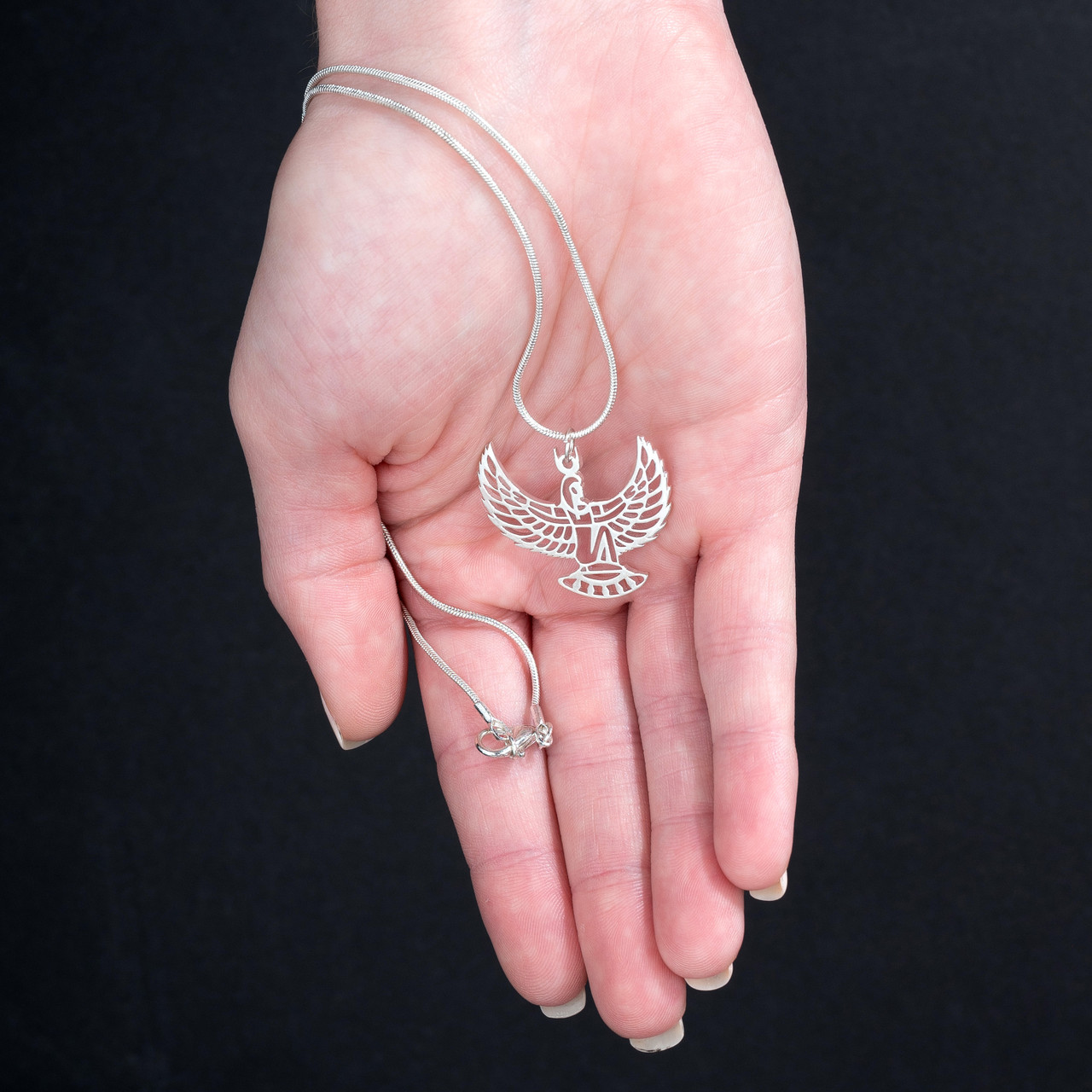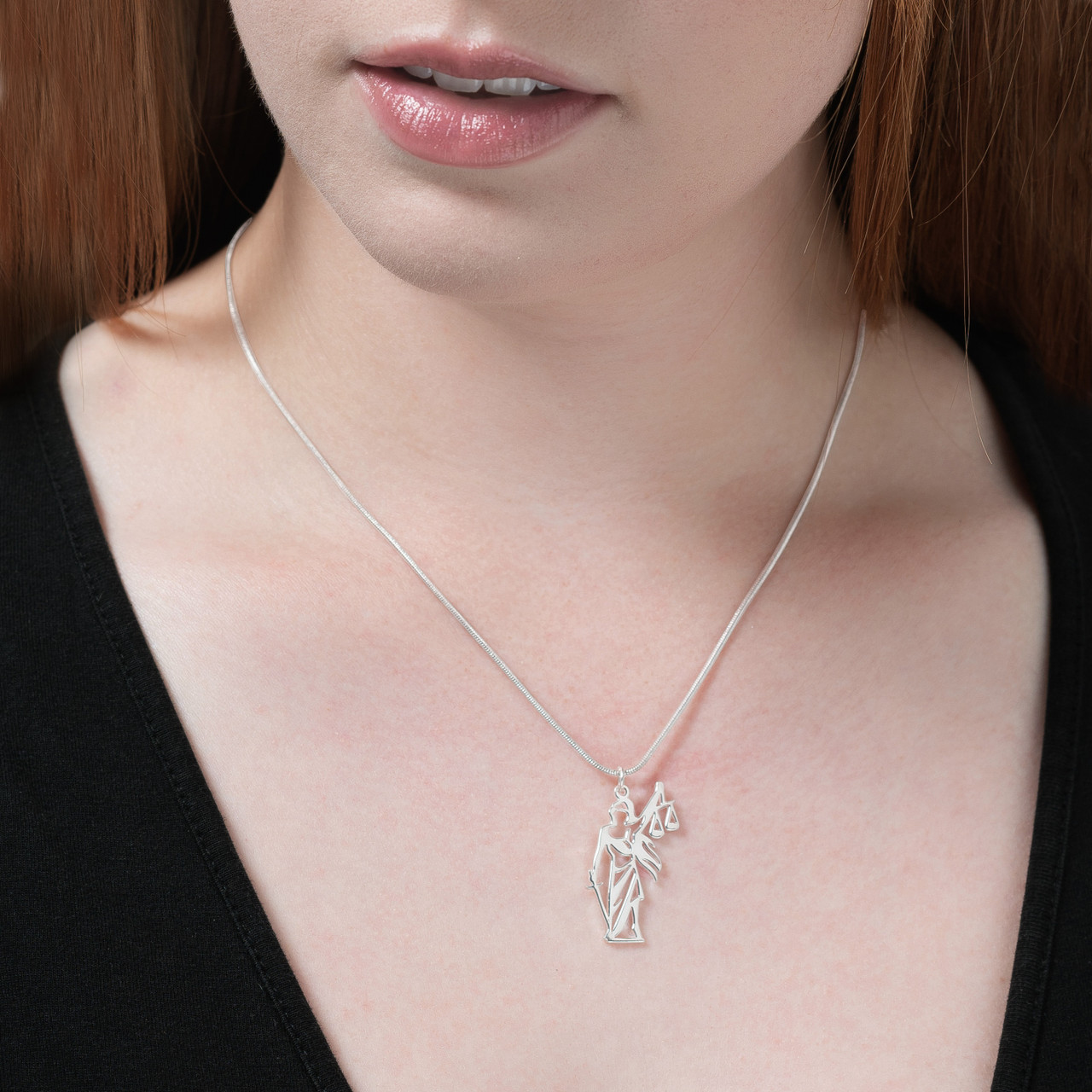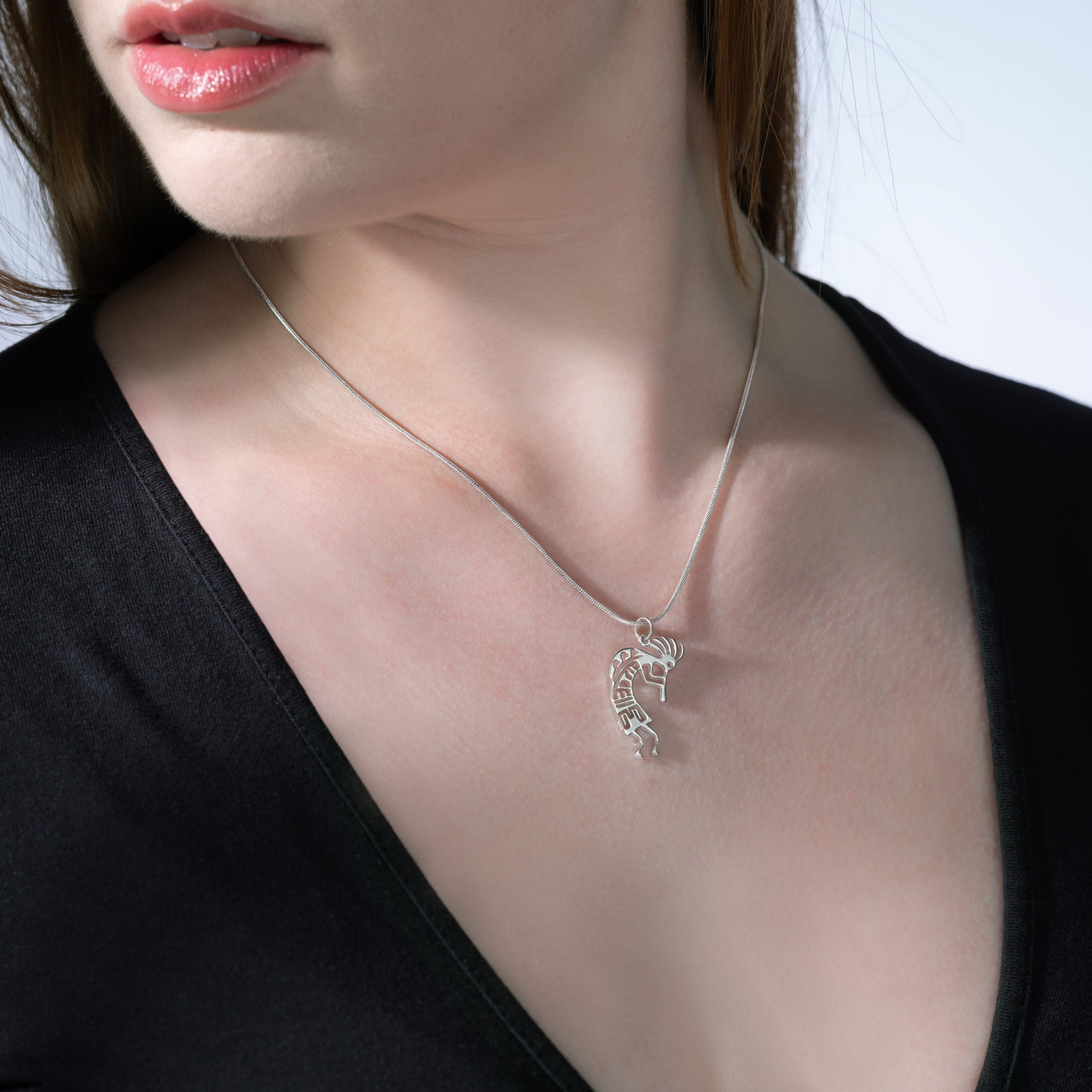The Renaissance Revival: Sterling Silver Pendant Trends Inspired by Art and Culture
Posted by Xandra Monde on Dec 12th 2023
Celebrating your culture and heritage has never been more popular than today. Those of us who take pride in how our families were shaped are always looking for new ways to embrace the adversity they overcame. The stunning jewelry collection offered by Xandra Monde (pronounced Zandra Mōnd) is one of a kind, and due to its uniqueness, it requires some explaining. In this article, we will look at...
- Origins of the 925 Sterling Silver Ma’at necklace, Lady Justice necklace, and Kokopelli Necklace
- Traditional and Contemporary cultural influence regarding the Ma’at’s necklace, Lady Justice necklace, and Kokopelli Necklace
- Sterling Silver Pendant Trends FAQs
Let’s dive in!
Ma’at in the 19th Dynasty tomb of Queen Nefertari, wife of Ramesses II. Circa 1256 BCE.
Ma’at Necklace Origin

Xandra Monde’s sterling silver Ma’at necklace is inspired by one of the most significant symbols to have contributed to contemporary culture. A large part of its significance stems from its distant origin. Ma’at’s estimated creation was approximately 2680 to 2190 Before Christ (BC) / Before Common Era (BCE), making it one of humanity’s first cultural symbols to ever have been created.Ma’at is a deity of powerful feminine nature who spreads her beautiful wings and feathers and is found on the side of the Temple of Sobek, Egypt.
In ancient Egyptian culture, Ma’at was seen as a religious symbol most significantly representing order, in addition to reciprocity, moderation, truth, justice, and balance.Ma’at was the goddess who kept everything in balance by reminding Egyptians to maintain a strong sense of morality and justice within their daily actions. She influenced every part of Egyptian society, guiding Egyptian leaders, philosophers, and law, with her most notable role serving as a goddess who judged those at death. Those who passed onto the afterlife would have to pass through the Hall of Judgement where their heart would be weighed on a scale against Ma’at’s feather of truth, which she held in her headband. A heart that balanced the scale against Ma’at’s feather, would be permitted to pass to the Afterlife—if not, their soul was destitute.
Ma’at’s Necklace Contemporary Significance
Ma’at is commonly found in modern society due to its strong religious and worldly foundations it has set forth. The idea that the world consists of order that can be studied and understood is often found in scientific communities today. Scientists must make the assumption that the system in which they are observing can be studied, understood, and repeated in order to make new discoveries. In a way—perhaps unknowingly--Ma’at is what drives the scientistic process leading to the modern innovations we see today.
The concept of Ma’at’s feathers and scales are commonly represented in Western judicial systems. An example of this would be Xandra Monde’s Lady Justice necklace. Commonly referred to as Lady of Justice, the Lady Justice necklace encapsulates and amplifies the idea that a person’s “heart” or moral character should be weighed against universal order to determine a person’s fate. This idea is the driving force in empathizing and showing compassion with the many individuals who may have been a victim of crime. We will speak more about the Lady Justice necklace in the next section.
Symbols such as the Ma’at necklace from Xandra Monde support the ongoing 925 Sterling silver pendant trends that are celebrating culture. The Ma’at necklace is a subtle and extremely cute way to celebrate order, reciprocity, justice, truth, moderation, and balance with family, friends, and strangers! It’s best for those who embrace the idea that there is more beyond our world than what we see.
Lady Justice Necklace Origin

The Lady Justice Necklace was inspired by the Lady of Justice which was founded in 800 BC / BCE. Symbolizing justice is a recurring theme in many cultures across the world. It’s clear this is a recurring theme due to the fact the Egyptians, the Romans, and the Greeks embraced the concept of justice for all. She represents fairness, equality, and honesty, which is suspected to have been derived from symbols such as Ma’at in the Ma’at Necklace Origin section.
The Lady of Justice is depicted wearing a dress and blindfold while holding a sword and balance scales. The dress represents her feminity which can be depicted as unconditional love. This unconditional love is representative of showing compassion for the accused by assuming innocence until proven guilty. She was originally without a blindfold to emphasize that she could clearly see all the relevant facts. The appearance of the blindfold was intermittent throughout the 16th century representing the judicial systems' abuse or ignorance of aspects of the law. The meaning of the blindfold would change later. She wields an unsheathed sword to illustrate the transparency required to maintain justice and remove fear of unknown prosecution. It is double-edged to spotlight justice applies to all and intended to represent enforcement and respect of the decision and ruling made—ultimately, her sword was about being able to take action to enforce justice. Similar to the Ma’at necklace, her balance scales represent impartiality in conjunction with the law’s obligation to weigh the evidence presented before the court.
Lady Justice’s Necklace Contemporary Significance
Lady Justice can most often be found in courthouses today and is still a common symbol representing modern tenets of legal philosophy. Like many cultural symbols, the meaning of the blindfold has changed. In modern times, the blindfold represents the impartiality and objectivity of the law while excluding outside factors such as wealth, fame, and politics. Although much controversy surrounds legal systems’ true impartiality today, the core philosophy is still a good one because it drives people to recognize the importance of remaining impartial while enforcing objectivity, compassion, and fairness. Without the Lady of Justice, it would be fair to say these concepts may have still remained foreign to us.
The Lady Justice necklace is Xandra Monde’s way of giving a voice to those who appreciate and live out the values mentioned earlier. This necklace makes a perfect gift for lawyers, peace officers, military members, and those friends who stand up for what is right even when times are tough. It’s the perfect way to remind yourself every day of the significance behind fighting evil in the pursuit of justice!
Kokopelli Necklace Origin

The Kokopelli necklace is a Native American necklace. Kokopelli is considered a fertility god of a few Native American tribes in the American Southwest and Mexico. The myth of Kokopelli was first discovered on Hogokam pottery around 750 to 850 After Death (AD) / CE. Kokopelli also made an appearance in 1000 AD / CE in pictographs and petroglyphs. The Kokopelli necklace depicts the hunchback playing a flute with a decorative crest on his head, which can arguably relate to the Pochtecas (pronounced poch-te-ca-s) who were traders traveling north from the Aztec lands. The Pochtecas were known for carrying large sacks on their back and are suspected of having blown flutes to broadcast their arrival.
Kokopelli was often associated with fertility, being a sharp-witted prankster, healer, and storyteller while paired with ideas such as trade, abundance, and exchange of material, ideas, music, and dance. His legacy became popular and spread through storytelling which caused his meaning to shift over time, where he began to be associated with rain and agriculture. His association with rain gave way to his association with fertility and the cycle of life, as desert tribes' relationship with rain was a seldom one. Rain was what gave way to the birth of new generations and crops. Kokopelli was often featured with Kokopelli Mana (also known as Kokopelmimi) who was considered to be the wife of Kokopelli.
Kokopelli Contemporary Significance
The contemporary meaning of the Kokopelli necklace varies. His most popular meaning is seen as a symbol of the American Southwest region—located in the United States near the Four Corners in the area north of the Mexican border. The essence of his character can be witnessed commonly through souvenirs such as t-shirts, pictures, and statues. Due to Kokopelli’s strong influence, it is also common to find Kokopelli and related cultural symbols in coffee shops, breakfast restaurants, and diners within the American Southwest.
The Kokopelli necklace is perfect for the individual who enjoys having a good time and keeps the cycle of life moving forward. It is a tribute to emphasizing the important values the life of the party might have to express entertainment in a fun and sharp-witted way. It’s a unique way to respectfully glorify our North American ancestors through the use of sterling silver pendant trends and keep Kokopelli’s journey alive and moving! In the end, it is the joker who is the savior to us all.
Sterling Silver Pendant Trends FAQs
Q: What does the Ma’at Necklace represent in contemporary culture?
The Ma’at necklace is a powerfully feminine way to participate in the sterling silver pendant trends due to the resilient values it represents such as, order, reciprocity, moderation, truth, justice, and balance.
Q: What does the Lady Justice Necklace represent in contemporary culture?
If you’re a strong supporter of fairness, equality, and honesty, the Lady Justice necklace is the perfect way to express to your peers your desire to defend victims who encounter unjust or evil situations.
Q: What does the Kokopelli Necklace represent in contemporary culture?
The Kokopelli Necklace is one of the most unique ways a person can embrace the joy that life offers. He is a perfect gift for those who know how to have fun and enjoy being the life of the party. He emphasizes the uniqueness offered through artistic heritage necklaces by embracing eternal traits related to healers, pranksters, storytellers, laughter, music, and rebirth.
Q: Where can I find artistic heritage necklaces?
Xandra Monde is an up-and-coming jewelry company striving to offer artistic heritage necklaces to passionate people who want to fashionably revitalize their positive cultural and moral values. Xandra Monde offers products ranging from, but not limited to, precious metal necklaces such as their Atlas necklace to their Notre Dame necklace to Faravahar necklace.
Q: What other necklaces are similar to the Ma’at Necklace and Lady Justice Necklace?
Xandra Monde offers a Hermes necklace and an Atlas necklace which represent nuanced aspects of Greek culture. A Greek mythology necklace can be a suitable way to represent more nuanced values exhibited by the many different Greek gods. The Hermes necklace represents trade, wealth, luck, fertility, animal husbandry (similar to a modern-day rancher), sleep, language, thieves, and travel. Whereas the Atlas necklace represents the Greek titan god of strength and endurance—the one who carries the weight of the world and heavens upon his shoulders.
Q: Can I submit recommendations of artistic heritage necklaces to Xandra Monde?
Yes, you can! Xandra Monde is making strides to cater to its customers interested in sterling silver pendant trends. Like the Ma’at Necklace, you may influence Xandra Monde’s culture resulting in your idea being mass-produced! Depending on the design request, Xandra Monde does have the capability to create unique custom necklace requests at a premium. Xandra Monde does not guarantee the manufacturing of any or all artistic heritage necklaces that are submitted, however, the company will be excited to respond with details specifying the feasibility and priority. The company will also provide you with alternatives if it cannot complete your request.

